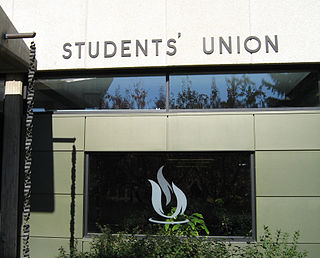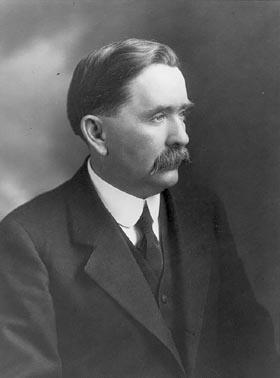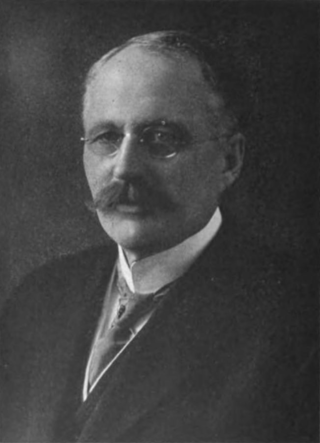
Alexander Cameron Rutherford was a Canadian lawyer and politician who served as the first premier of Alberta from 1905 to 1910. Born in Ormond, Canada West, he studied and practiced law in Ottawa before he moved with his family to the North-West Territories in 1895. Besides his work as lawyer, he began a political career that would see him first serve as member of the North-West Legislative Assembly and then as Liberal MLA, Liberal party leader, and premier of Alberta. He lost the premiership in 1910 due to the Alberta and Great Waterways Railway scandal and his Legislature seat in 1913. He later was prominent in the administration of the University of Alberta, beside which he and his family lived for decades. His home, Rutherford House, is an historic site on the grounds of the University of Alberta.

The University of Alberta is a public research university located in Edmonton, Alberta, Canada. It was founded in 1908 by Alexander Cameron Rutherford, the first premier of Alberta, and Henry Marshall Tory, the university's first president. It was enabled through the Post-secondary Learning Act. The university is considered a "comprehensive academic and research university" (CARU), which means that it offers a range of academic and professional programs that generally lead to undergraduate and graduate level credentials.

The University of Alberta Students' Union (UASU) is the student society that represents undergraduate students at the University of Alberta. Originally established in October 1908 as the Students' Council, the UASU is a non-profit corporation that operates under the authority of the Post-Secondary Learning Act (Alberta). Its membership consists of the roughly 31,000 undergraduate students enrolled at the university.

William Henry Cushing was a Canadian politician. Born in Ontario, he migrated west as a young adult where he started a successful lumber company and later became Alberta's first Minister of Public Works and the 11th mayor of Calgary. As Minister of Public Works in the government of Alexander Cameron Rutherford, he oversaw the creation of Alberta Government Telephones.
Khaki University was a Canadian overseas educational institution set up and managed by the general staff of the Canadian Expeditionary Force (CEF) in Britain 1917–19 during the First World War. The system, named for the khaki-coloured uniforms of the CEF, was set up by the efforts of Henry Marshall Tory and Edmund Henry Oliver and was supported by the Young Men's Christian Association (YMCA). This university with makeshift colleges mainly in central England provided education on a range of subjects to more than 50,000 soldiers and the certificates given were accepted by Canadian universities. The term was used again for Canadian educational programs for veterans from 1945–46 after the Second World War.

Murdoch Maxwell MacOdrum was the second president of Carleton College in Ottawa, Ontario. Born in Nova Scotia, MacOdrum got his B.A. from Dalhousie University in 1923, his MA in 1925 from McGill and a PhD in English from the University of Edinburgh. In 1935 he was ordained as a Presbyterian minister in Sydney, N.S., where he ministered for four years.
Alice Major is a Canadian poet, writer, and essayist, who served as poet laureate of Edmonton, Alberta.
Elizabeth Sterling Haynes was an Alberta theatre activist. Haynes was a driving force in the Little Theatre Movement in Alberta.

John Robert Boyle was a Canadian politician and jurist who served as a Member of the Legislative Assembly of Alberta, a cabinet minister in the Government of Alberta, and a judge on the Supreme Court of Alberta. Born in Ontario, he came west and eventually settled in Edmonton, where he practiced law. After a brief stint on Edmonton's first city council, he was elected in Alberta's inaugural provincial election as a Liberal. During the Alberta and Great Waterways Railway scandal, he was a leader of the Liberal insurgency that forced Premier Alexander Cameron Rutherford from office.

James Cranswick Tory was a Nova Scotia businessman and politician. He was born in 1862 to Robert Kirk Tory and Anorah Ferguson in Guysborough County and lived in the village of Guysborough. He attended McGill University in Montreal and worked at Sun Life Assurance Company. In 1894, he married Caroline Whitman. Tory served as a Liberal MLA for Guysborough County in the Nova Scotia House of Assembly from 1911 to 1925. He was a minister without portfolio in the province's Executive Council from 1921 to 1925. Tory was appointed the 14th Lieutenant Governor of Nova Scotia and served from 1925 to 1930. He died in Halifax.
Robert Kirk Tory was a Methodist minister in Nova Scotia.
The Tory family is a prominent family of lawyers and politicians in Canada, some members of which are associated with the Toronto law firm Torys. The family traces its roots back to Nova Scotia and James Tory (1753–1834), who migrated there from Aberdeenshire, Scotland. The family's greatest influence is in Ontario, beginning with John Alexander Tory Sr.

Robert William Boyle was a physicist and one of the most important early pioneers in the development of sonar.
The Canadian Political Science Association is an organization of political scientists in Canada. It is a bilingual organization and publishes the bilingual journal Canadian Journal of Political Science. The organization is headquartered in Ottawa, Ontario, and has an annual convention in conjunction with the Canadian Federation for the Humanities and Social Sciences. It was founded in 1912.
The following is a bibliography of Alberta history.

The Department of Mathematics and Statistics is an academic department at McGill University. It is located in Burnside Hall at McGill's downtown campus in Montreal.
The University of Alberta Library is the library system of the University of Alberta.
Edward Annand Corbett (1884-1964) was an innovator and pioneer adult educator in Canada. Born on April 12, 1884 in Truro, Nova Scotia to Rev. Thomas Corbett and Agnes Harriett (Crowe) Corbett his early life included moves to Tyne Valley, Prince Edward Island; Blackville, New Brunswick and Rockburn, Quebec.

The Wauneita Society was a women's group at the University of Alberta from 1908 to 1973. For many decades, it functioned as a support system for the relatively few female students on campus. The group organized lectures, social events, and fundraisers, and eventually operated its own women-only study hall in the old Students' Union Building. The group's core traditions and identity were heavily appropriated from stereotypes of Cree culture, at a time in Canadian history when Indigenous communities were criminalized for practising their culture.














